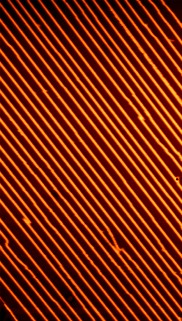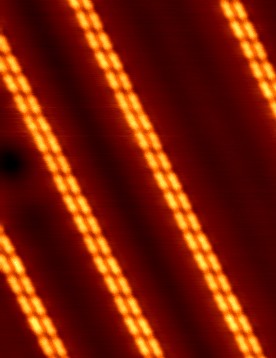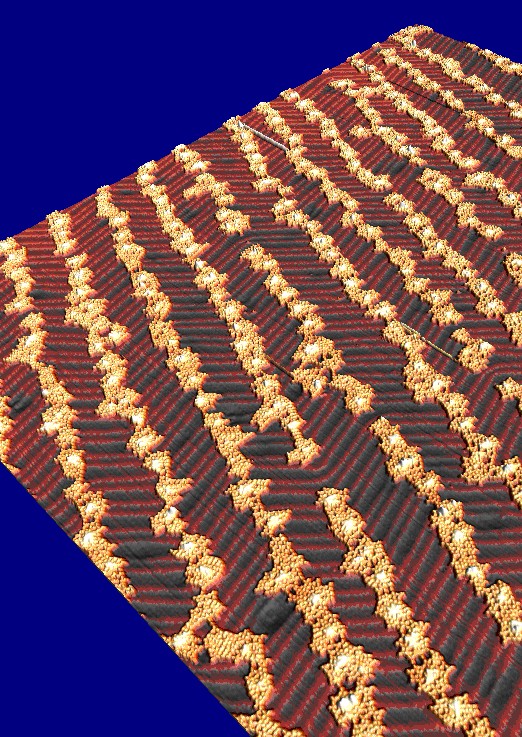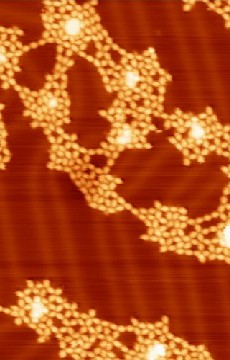The basic idea of molecular engineering is to create supramolecular architectures and nanostructures from molecular building blocks which are interconnected by chemical bonds, predominantly of noncovalent character. In our group we study the self-assembly phenomena of organic molecules on metal surfaces. The aim is to steer the organization and function of the nanostructures by the design of the molecules (FUN_SMARTs project) and to understand basic mechanism which are needed to make molecular machines (BioMach project). By deposition of metal atoms a side with the molecules metallosupramolecular arrangements can be achieved, which are of interest for studying magnetism on the nanoscale (joint project with H. Brune’s group at ICMP-LNS). In cooperation with which are of special A scanning tunneling microscope is used at low temperature and ultra high vacuum to obtain experimental data on the topography and the chemical properties of the arrangements. The experimental data is enriched by measurements with other methods like Near Edge X-ray Absorption Fine Structure (NEXAFS) and X-ray photonemission spectroscopy (XPS) which are carried out at the BESSY in Berlin or at the EMPA in Thun. For the analysis theoretical help is provided by the group around A. de Vita undertaking density functional theory (DFT) calculations.


In this example, we studied the ordering of 4-[trans-2-(pyrid-4-yl-vinyl)] benzoic acid (PVBA) at the noble metal surfaces Ag(111). The PVBA represents a chiral species, when deposited on a surfaces. It was found that homochiral molecules self-assemble in supramolecular chiral hydrogen-bonded twin chains [right picture], which order in nanogratings [left picture]. The supramolecular chirality within one domain of the nanograting, the length of which is in the µm range, is strictly correlated over the entire domains without intimate molecular contact. Model simulations indicate that the underlying mesoscopic chiral resolution is associated with twin chains acting as chiroselective templates for transient molecular attachment, which process mediates the gratings’ evolution.
fig.: 1D supramolecular nanograting fabricated by H-bond mediated self-assembly of PVBA molecules on a Ag(111) surface.


The second example shows the result of first experiments concerning nanopatterning of metallosupramolecular assembly on a metal surface. For this purpose, we took advantage of the naturally textured Au(111) surface in order to obtain a selective growth of metallic nano-dots at well ordered sites on the surface. These nanostructures [white spots, right picture] were used as reservoirs of metal atoms for the local coordination with Terephthalic Acid (TPA) molecules [smaller yellow dots, right picture]. The metal-terephthalate system resulting from the reaction of TPA with metal atoms can be seen as a building block involved in a supramolecular structure stabilized by metal-ligand bonds. The tuning of the deposition parameters allows the steering of different metal-organic architectures. The localization of the reaction and the local anisotropy of the metal atom reservoir pattern favor one-dimensional (1D) growth of metal-organic supramolecular architectures as it is shown in the left picture.
fig.: 1D supramolecular nanograting fabricated by H-bond mediated self-assembly of PVBA molecules on a Ag(111) surface.
Key Publication
“Steering molecular organization and host–guest interactions using two-dimensional nanoporous coordination systems”
S. Stepanow, M. Lingenfelder, A. Dmitriev, H. Spillmann, E. Delvigne, N. Lin, X. Deng, C. Cai, J.V. Barth, and K. Kern,
Nature Mat. 3, 229 (2004) (pdf).
“Supramolecular architectures and nanostructures at metal surfaces”
J.V. Barth, J. Weckesser, N. Lin, A. Dmitriev, and K. Kern,
Appl. Phys. A 76, 645 (2003) (pdf).
“Stereochemical Effects in Supramolecular Self-Assembly at Surfaces: 1-D versus 2-D Enantiomorphic Ordering for PVBA and PEBA on Ag(111)”
J.V. Barth, J. Weckesser, G. Trimarchi, M. Vladimirova, A. De Vita, C. Cai, H. Brune, Peter Günter, and K. Kern,
J. AM. CHEM. SOC. 124, 7991 (2002) (pdf).
“Mesoscopic correlation of supramolecular chirality in one-dimensional hydrogen-bonded assemblies”
J. Weckesser, A. De Vita, J.V. Barth, C. Cai, and K. Kern,
Phys. Rev. Lett. 87, 096101 (2001) (pdf).
“Building supramolecular nanostructures at surfaces by hydrogen bonding”
J.V. Barth, J. Weckesser, C. Cai, P. Günter, L. Bürgi, O. Jeandupeux, and K. Kern,
Angewandte Chemie 112, 1285 (2000) (pdf);
Angewandte Chemie Int. Ed. 39, 1230 (2000) (pdf).